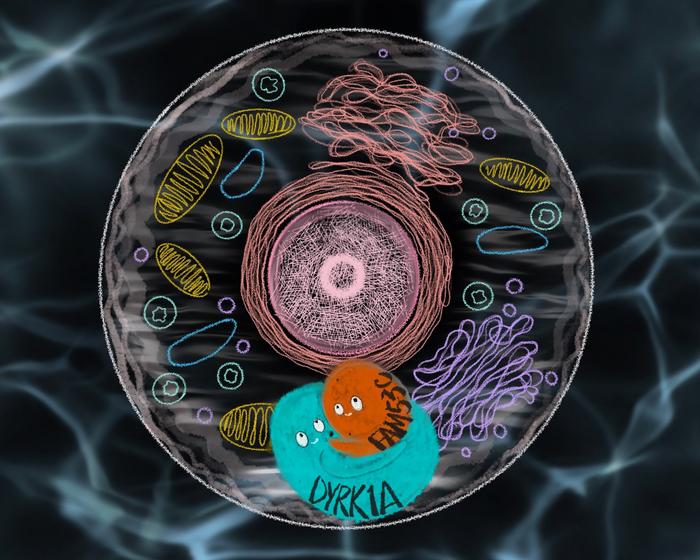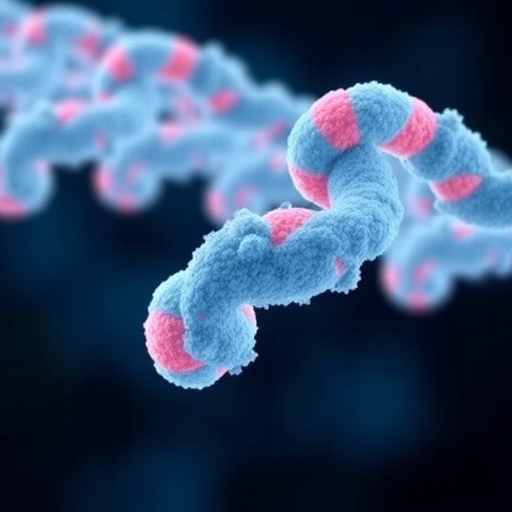Kyoto, Japan — Down syndrome, a congenital disorder stemming from abnormal cell division and differentiation, is most common in newborns fated to neurodevelopmental delays and other health complications.

Credit: Credit: KyotoU/Jake G Tobiyama/Yoshihiko Miyata
Kyoto, Japan — Down syndrome, a congenital disorder stemming from abnormal cell division and differentiation, is most common in newborns fated to neurodevelopmental delays and other health complications.
The genetic defect causes the dysfunction of the protein kinase DYRK1A, which is encoded on chromosome 21 and is deeply associated with both Down syndrome and autism spectrum disorder. DYRK1A has attracted attention as a target molecule for treating various diseases, but specific cellular mechanisms regulating the enzyme DYRK1A have yet to be made clear.
Now, researchers at Kyoto University have identified the FAM53C protein and its DYRK1A-inhibiting effect that keeps the protein kinase inactive inside the cytoplasm.
“Our findings demonstrate the important role of the intracellular regulatory mechanism of DYRK1A in the normal development and function of the neuropsychiatric system,” says first author Yoshihiko Miyata at KyotoU’s Graduate School of Biostudies.
“The molecular regulation of the highly complex development and activity of the human brain fascinates me,” adds Miyata. In addition to neuropsychiatric symptoms, Down syndrome may also cause early onset of Alzheimer’s disease, type 2 diabetes, and facial maldevelopment.
“Given DYRK1A’s significance, we have explored potential molecules serving as its interacting counterpart,” says Miyata.
DYRK1A controls many biological functions, including the development and function of the nervous system. At the cellular level, this critical protein phosphorylates various other proteins in the cytoplasm and nucleus to regulate the cell cycle, cell differentiation, cytoskeletal formation, and DNA damage response.
After identifying DCAF7/WDR68 as a major binding protein for DYRK1A in a previous study, Miyata’s team used mass spectrometry to uncover other interacting proteins that modulate DYRK1A’s function and cellular location. Notably, the structurally flexible FAM53C protein binds directly to a region of DYRK1A responsible for protein phosphorylation. This interaction reduces DYRK1A’s kinase activity, securely anchoring DYRK1A within the cytoplasm but outside the cell nucleus, as in normal brain tissue.
“The FAM53C-mediated regulation of the protein kinase activity may significantly impact gene expression regulation caused by normal and aberrant levels of DYRK1A, giving us many potential clinical insights,” suggests Miyata.
###
The paper “Identification of FAM53C as a cytosolic-anchoring inhibitory binding protein of the kinase DYRK1A” appeared on 6 October 2023 in Life Science Alliance, with doi: 10.26508/lsa.202302129
About Kyoto University
Kyoto University is one of Japan’s and Asia’s premier research institutions. Founded in 1897, it is responsible for producing numerous Nobel laureates and winners of other prestigious international prizes. A broad curriculum across the arts and sciences at undergraduate and graduate levels complements multiple research centers, facilities and offices around Japan and the world. For more information, please see: http://www.kyoto-u.ac.jp/en
Journal
Life Science Alliance
DOI
10.26508/lsa.202302129
Method of Research
Experimental study
Subject of Research
Cells
Article Title
Identification of FAM53C as a cytosolic-anchoring inhibitory binding protein of the kinase DYRK1A
Article Publication Date
6-Oct-2023
COI Statement
The authors declare that they have no conflict of interest.




